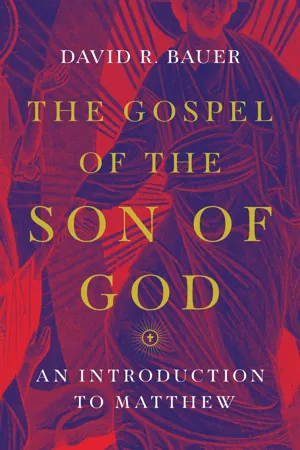Thus a genre is actually an implicit code by which the writer directs the audience to adopt reading strategies that are appropriate to that genre and discourages those reading strategies that may be proper to other genres but unsuitable to the one being employed. Persons living in a certain culture are naturally familiar with the genres available and under most circumstances will almost subconsciously recognize a genre and read according to its implicit set of expectations. But it is possible that readers who confront literature produced in another culture, with its own pool of genres, will misidentify the genre and read that literary product in ways that contradict its generic intentions. This consideration points to the importance of our identifying the genre of the Gospel of Matthew and utilizing insights from that generic determination to interpret it.
THE GENRE OF THE GOSPELS
The similarity of content and arrangement among the four canonical Gospels suggests that they share a common genre, and such has been the general consensus throughout the past two hundred years.3 But this period has also witnessed disagreement regarding precisely what that genre is. We may identify three stages in the scholarly debate on this question.4
As for the first stage, scholarly attention to the issue of the Gospels’ genre began in the nineteenth century. That century saw the emergence of the modern biography, and it was natural that nineteenth-century readers, including scholars, would construe the Gospels according to this popular literary form. Scholars often produced their own biographies or lives of Jesus and treated the Gospels as earlier manifestations of that same genre; indeed, scholars mined the Gospels for their own nineteenth-century reconstructions. But even scholars who did not produce their own biographies of Jesus approached the Gospels along the lines established by modern biographies. The forging of such a connection between the Gospels and the modern biographical movement was to be expected since the Gospels focus on the person of Jesus and present an account of his deeds and teachings. Some of these scholars, notably Ernst Renan and Clyde Weber Votaw, attempted to compare the Gospels with works of ancient biography roughly contemporary to our Gospels; yet even in these cases a tendency existed to assume more continuity between ancient biographical works and modern biography than was warranted.5
But scholars increasingly realized that serious differences existed between modern biographies and the Gospels. For example, modern biographies typically present the life of the subject by reporting all the significant events of that subject’s life in strict chronological sequence, while the Gospels pass over whole periods of Jesus’ life. Indeed, Mark and John tell us nothing of Jesus’ birth and early life but rather begin with Jesus’ adulthood, and Matthew and Luke skip over the period from Jesus’ infancy to his adulthood with the exception of only one vignette offered by Luke (Lk 2:41-51). And the evangelists typically chart the events of Jesus’ life in a chronologically loose way, usually with only vague connectives,6 thus often making it difficult for those who are accustomed to the explicit development of a subject’s life in modern biographies to note the precise relationship of individual events to one another within the Gospels.7
In addition, modern biographies are characterized by careful attention to the psychological, social, and moral development of the subject, and the factors that contributed to such development. But these considerations are conspicuously absent in our Gospels. We learn little of the influences that contributed to Jesus’ character. In fact, the Gospels contain no reference to any sort of personal, moral, or spiritual development in Jesus.8
Finally, modern biographers tend to limit attention to empirically verifiable phenomena, that is, to those things that can be observed on the human-historical plane, while our Gospels embrace the perspective that the ultimate actor in history, including and especially the history of Jesus, is God. Correspondingly, our Gospels are written from a strong theological perspective. In other words, according to the Gospels, transcendent theological realities are ultimately determinative for understanding the life of Jesus; and in the Gospels the story of Jesus is shaped by these theological interests. For the most part, then, nineteenth-century scholarship filtered out these transcendent and theological elements in their reading of the Gospels, or at least in their reconstruction of the life of Jesus from their examination of the Gospels.9
This understanding of the Gospels in terms of biography as historical reportage thus eventually proved untenable,10 and at the beginning of the twentieth century a significant reconsideration of the genre of the Gospels occurred. This shift marks the second stage of scholarly work on the Gospels’ genre. The differences between the Gospels and modern biographies or ancient biographies construed more or less along the lines of modern biographies led scholars to abandon the notion that the Gospels shared the genre of biography. Rather, they viewed the Gospels either as folk literature that emerged from an oral, storytelling tradition and thus lacked the literary sophistication that made any genre identification useful,11 or as constituting a unique genre (sui generis). The notion that the Gospels represent a unique genre that emerged as an outgrowth of the earliest Christian preaching, or kerygma, and thus were not formally comparable to any other writing, became the increasingly dominant position.12
This view of the Gospels as sui generis held sway until approximately 1980 when the third stage of scholarly investigation into the Gospels’ genre took hold with a series of books that argued, in different ways and with varying degrees of success, that the Gospels belong to the genre of ancient biography. In contrast to the nineteenth-century advocates of the biographical genre, the authors of these more recent works attended seriously to the differences between modern and ancient biography. Moses Hadas and Morton Smith argued that the Gospels are aretalogies, a subcategory of ancient biography which described the miraculous deeds of a hero or a god in such a way as to urge readers to emulate him and follow his teachings.13 Philip Shuler insisted that the Gospels, and in particular the Gospel of Matthew, are an example of “laudatory biography,” or encomium, which was produced to heap praise on the subject.14 Unfortunately, these scholars were unable to identify compelling examples in the ancient world of such specific genres. More significant was Charles Talbert’s 1977 volume What Is a Gospel? The Genre of the Canonical Gospels, in which he argued that our Gospels represent various versions of ancient biography.15 Yet in the judgment of many all three of these works lacked an adequate theory of genre and made claims regarding ancient biographical writings that failed to bear up under scrutiny.
This critique was made especially by Richard A. Burridge, who sought to address these shortcomings in his monumental study, What Are the Gospels? A Comparison with Graeco-Roman Biography. On the basis of a sophisticated theory of genre and a careful comparison of ancient biographies to the Gospels, he argued that the Gospels belong to the genre of ancient biography in general and cannot be identified with any more specific subcategory of biography.16 According to Burridge, the Gospels share by far the majority of the characteristics found in ancient biographies, or βίοι. This broad, though not absolute, correspondence is sufficient to establish the Gospels as biographies, since genre classification allows for some flexibility and does not demand absolute conformity at each point; we cannot expect any one ancient biography to exhibit all the standard characteristics of the genre. Indeed, the Gospels diverge no more from the several standard characteristics of ancient biographies than do a number of ancient documents which were clearly and explicitly considered βίοι. This book is probably the most significant treatment ever produced on the topic of the Gospels’ genre. Since its publication a scholarly consensus has formed that the Gospels belong to the genre of ancient biography.17
THE GENRE OF MATTHEW
In the volume just described Burridge identified eighteen characteristics of ancient biography and insisted that our Gospels share by far the majority of these characteristics, which are more than enough to establish a “family resemblance.”18 We turn now to the Gospel of Matthew and note the specific ways it reflects the generic characteristics of ancient biography.
Title. Ancient biographies usually included a title which identified the genre (βίοι) and the name of the writer, typically in the genitive. Such a title is lacking in the Gospel of Matthew. The title “The Gospel According to Matthew” (εὐαγγέλιον κατά Μαθθαῖον), along with the comparable titles of the other three Gospels, was added later, probably around AD 100.19 Moreover, in these titles the name does not appear in the genitive but in the accusative within a prepositional phrase, thus “according to Matthew” (κατά Μαθθαῖον). Here then we have a distinction between the Gospel of Matthew and that which we usually find in ancient biographies.
Opening formula/prologue/preface. Ancient biographies often begin with a preface or prologue, or at least mention the name of the subject at the very beginning of the book. Although Luke’s Gospel contains a prologue (Lk 1:1-4) it is not clear that such is the case with the Gospel of Matthew. The genealogy of Jesus in Matthew 1:1-17 may serve as a prologue,20 but as we will see below in our discussion of the structure of the Gospel of Matthew it is more likely that the genealogy belongs to the whole of Matthew 1:1–4:16 as a structural unity. Yet Matthew mentions Jesus explicitly at the very beginning of his Gospel (Mt 1:1).
Subject of the verbs. In ancient biographies the person who is the subject of the biography is usually also the grammatical subject of a proportionately larger number of verbs than anyone else mentioned in the book. The Gospel of Matthew qualifies according to this criterion, since Jesus is the subject of 17.2 percent of the verbs, versus the disciples who are the subject of 8.8 percent and the religious leaders who are the subject of 4.4 percent of the verbs.21
Allocation of space. Ancient biographies may give a disproportionate amount of space to certain periods in the subject’s life, especially to the death (and events consequent to the death) of the subject. According to this criterion, the fact that Matthew passes over the many years between Jesus’ infancy and his baptism (Mt 3:1) while devoting approximately 40 percent of the total narrative to the last several weeks of Jesus’ ministry through his death and resurrection is entirely within the realm of expectation for ancient biographies.22
Mode of presentation. Ancient biographies are written in prose narrative, yet often with the inclusion of other forms at points. Clearly the Gospel of Matthew is prose narrative, presenting a continuous story from beginning to end, while repeatedly introducing blocks of teaching. All of this is clearly in line with the expectations of ancient biography.
Size. Ancient biographies are typically between five thousand and thirty thousand words in length. With 18,305 words the Gospel of Matthew is clearly in the middle of this range.23
Structure. Ancient biographies are typically structured according to a broad c...

